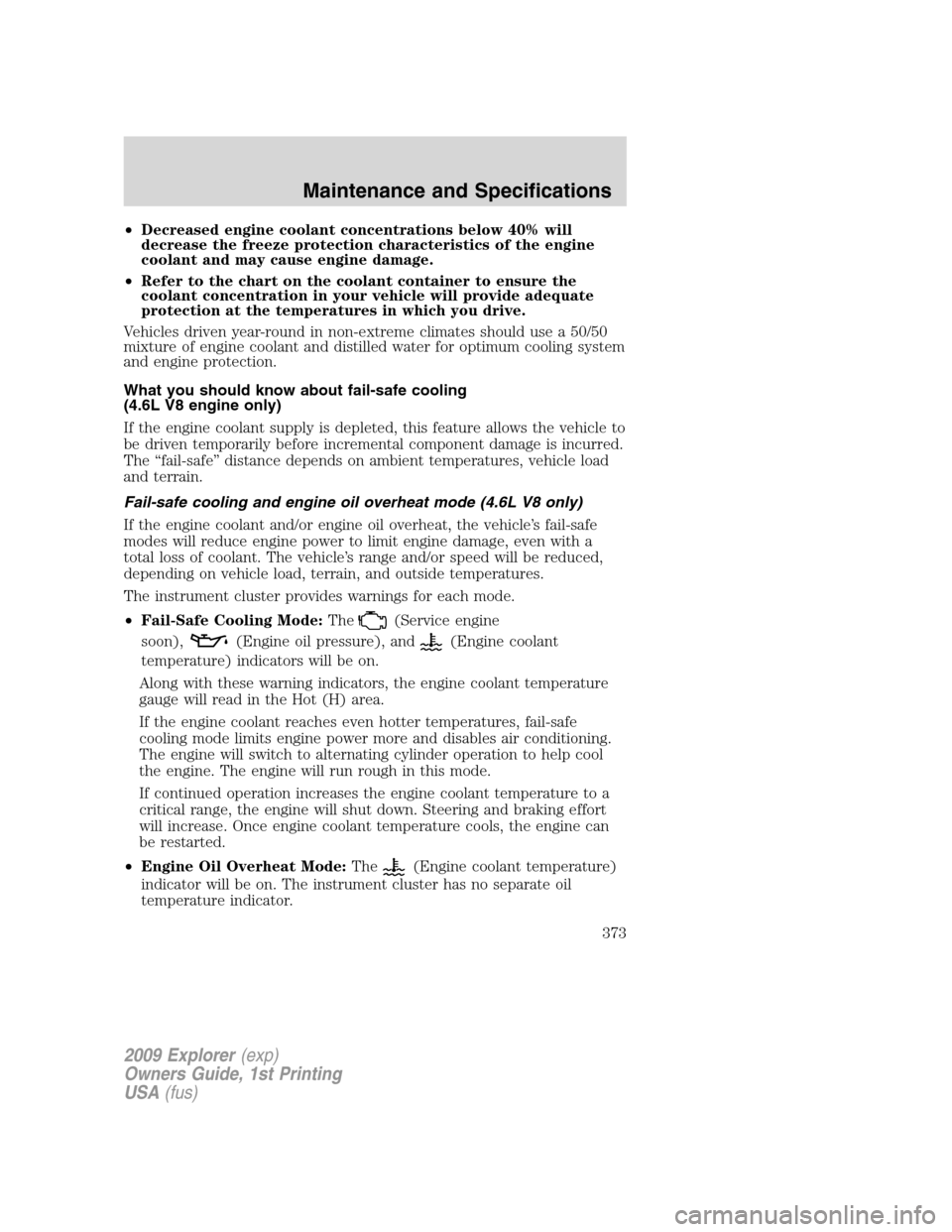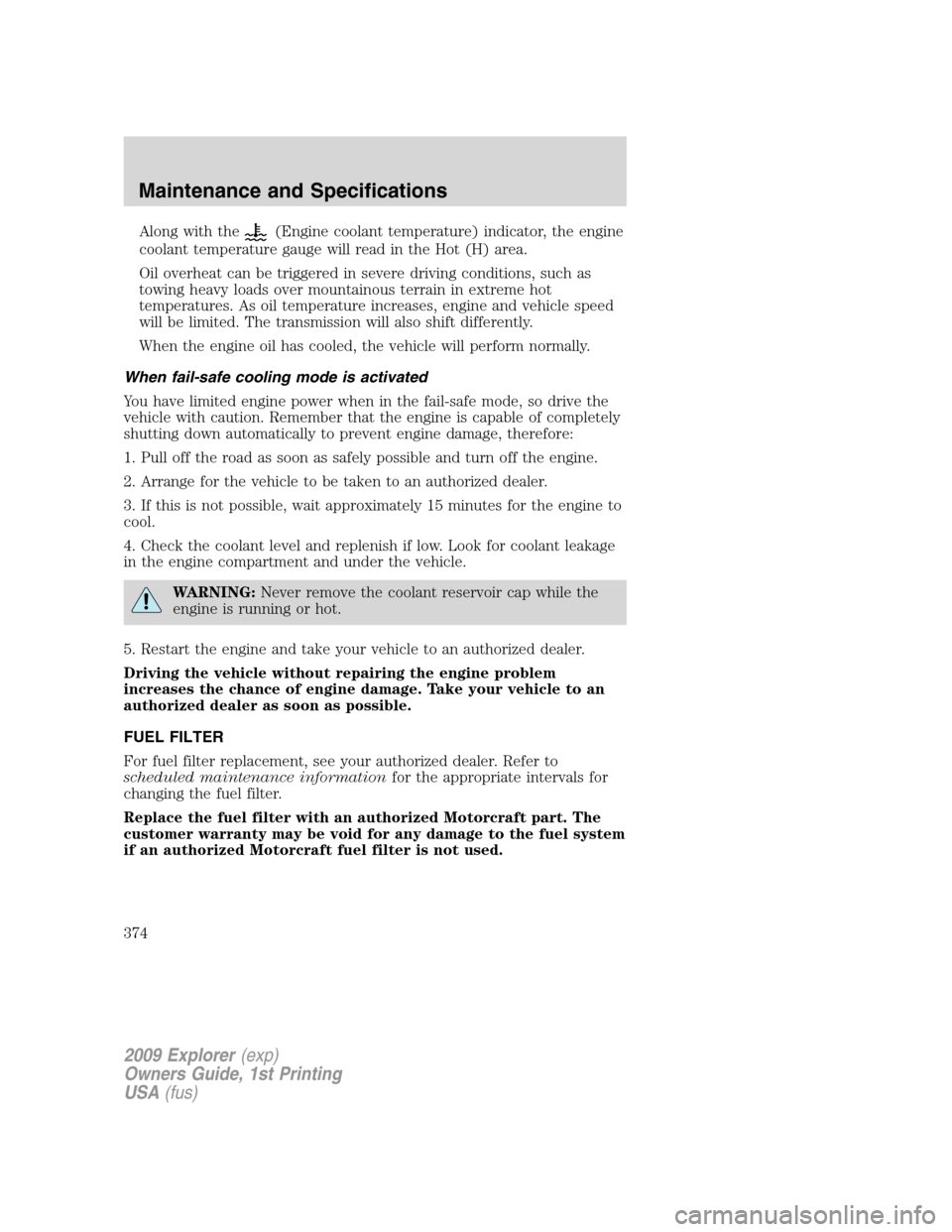Page 373 of 407

•Decreased engine coolant concentrations below 40% will
decrease the freeze protection characteristics of the engine
coolant and may cause engine damage.
•Refer to the chart on the coolant container to ensure the
coolant concentration in your vehicle will provide adequate
protection at the temperatures in which you drive.
Vehicles driven year-round in non-extreme climates should use a 50/50
mixture of engine coolant and distilled water for optimum cooling system
and engine protection.
What you should know about fail-safe cooling
(4.6L V8 engine only)
If the engine coolant supply is depleted, this feature allows the vehicle to
be driven temporarily before incremental component damage is incurred.
The “fail-safe” distance depends on ambient temperatures, vehicle load
and terrain.
Fail-safe cooling and engine oil overheat mode (4.6L V8 only)
If the engine coolant and/or engine oil overheat, the vehicle’s fail-safe
modes will reduce engine power to limit engine damage, even with a
total loss of coolant. The vehicle’s range and/or speed will be reduced,
depending on vehicle load, terrain, and outside temperatures.
The instrument cluster provides warnings for each mode.
•Fail-Safe Cooling Mode:The
(Service engine
soon),
(Engine oil pressure), and(Engine coolant
temperature) indicators will be on.
Along with these warning indicators, the engine coolant temperature
gauge will read in the Hot (H) area.
If the engine coolant reaches even hotter temperatures, fail-safe
cooling mode limits engine power more and disables air conditioning.
The engine will switch to alternating cylinder operation to help cool
the engine. The engine will run rough in this mode.
If continued operation increases the engine coolant temperature to a
critical range, the engine will shut down. Steering and braking effort
will increase. Once engine coolant temperature cools, the engine can
be restarted.
•Engine Oil Overheat Mode:The
(Engine coolant temperature)
indicator will be on. The instrument cluster has no separate oil
temperature indicator.
2009 Explorer(exp)
Owners Guide, 1st Printing
USA(fus)
Maintenance and Specifications
373
Page 374 of 407

Along with the(Engine coolant temperature) indicator, the engine
coolant temperature gauge will read in the Hot (H) area.
Oil overheat can be triggered in severe driving conditions, such as
towing heavy loads over mountainous terrain in extreme hot
temperatures. As oil temperature increases, engine and vehicle speed
will be limited. The transmission will also shift differently.
When the engine oil has cooled, the vehicle will perform normally.
When fail-safe cooling mode is activated
You have limited engine power when in the fail-safe mode, so drive the
vehicle with caution. Remember that the engine is capable of completely
shutting down automatically to prevent engine damage, therefore:
1. Pull off the road as soon as safely possible and turn off the engine.
2. Arrange for the vehicle to be taken to an authorized dealer.
3. If this is not possible, wait approximately 15 minutes for the engine to
cool.
4. Check the coolant level and replenish if low. Look for coolant leakage
in the engine compartment and under the vehicle.
WARNING:Never remove the coolant reservoir cap while the
engine is running or hot.
5. Restart the engine and take your vehicle to an authorized dealer.
Driving the vehicle without repairing the engine problem
increases the chance of engine damage. Take your vehicle to an
authorized dealer as soon as possible.
FUEL FILTER
For fuel filter replacement, see your authorized dealer. Refer to
scheduled maintenance informationfor the appropriate intervals for
changing the fuel filter.
Replace the fuel filter with an authorized Motorcraft part. The
customer warranty may be void for any damage to the fuel system
if an authorized Motorcraft fuel filter is not used.
2009 Explorer(exp)
Owners Guide, 1st Printing
USA(fus)
Maintenance and Specifications
374
Page 387 of 407

POWER STEERING FLUID
Check the power steering fluid. Refer toscheduled maintenance
informationfor the service interval schedules.
1. Start the engine and let it run
until it reaches normal operating
temperature (the engine coolant
temperature gauge indicator will be
near the center of the normal area
between H and C).
2. While the engine idles, turn the
steering wheel left and right several
times.
3. Turn the engine off.
4. Check the fluid level in the reservoir.
5. The fluid level should be between the MIN and MAX lines. Do not add
fluid if the level is in this range.
6. If the fluid is low, add fluid in small amounts, continuously checking
the level until it reaches the correct operating range. Be sure to put the
cap back on the reservoir. Refer toMaintenance product specifications
and capacitiesin this chapter for the proper fluid type.
BRAKE FLUID
The fluid level will drop slowly as
the brakes wear, and will rise when
the brake components are replaced.
Fluid levels between the “MIN” and
“MAX” lines are within the normal
operating range; there is no need to
add fluid. If the fluid levels are
outside of the normal operating
range the performance of the
system could be compromised; seek
service from your authorized dealer
immediately.
2009 Explorer(exp)
Owners Guide, 1st Printing
USA(fus)
Maintenance and Specifications
387
Page 402 of 407

Cleaning your vehicle
engine compartment ..............349
instrument panel ....................351
interior .....................................352
plastic parts ............................350
washing ....................................347
waxing .....................................348
wheels ......................................348
wiper blades ............................350
Climate control (see Air
conditioning or Heating) ............84
Clock adjust
6-CD in dash .............................35
AM/FM/CD .................................27
Compass, electronic ..................129
calibration ...............................130
set zone adjustment .......130, 144
Console ..............................103–104
overhead ..................................102
rear ..........................................104
Controls
power seat ...............................174
steering column ......................114
Coolant
checking and adding ..............368
refill capacities ................372, 392
specifications ..........................392
Cruise control
(see Speed control) ..................111
Customer Assistance ................310
Ford Extended Service
Plan ..........................................343
Getting assistance outside the
U.S. and Canada .....................344
Getting roadside assistance ...310
Getting the service you
need .........................................339
Ordering additional owner’s
literature .................................345Utilizing the
Mediation/Arbitration
Program ...................................343
D
Daytime running lamps
(see Lamps) ................................90
Defrost
rear window ..............................88
Dipstick
automatic transmission
fluid ..........................................388
engine oil .................................361
Driveline universal joint and
slip yoke ....................................389
Driving under special
conditions ..................296, 303, 306
sand .........................................305
snow and ice ...........................307
through water .................306, 309
Dual automatic temperature
control (DATC) ...........................84
DVD system .................................49
E
Electronic message
center .................................123, 135
Emergencies, roadside
jump-starting ..........................331
running out of fuel .........331, 379
Emergency Flashers .................311
Emission control system ..........384
Engine ........................................396
cleaning ...................................349
coolant .....................................368
fail-safe cooling .......................373
idle speed control ...................366
2009 Explorer(exp)
Owners Guide, 1st Printing
USA(fus)
Index
402